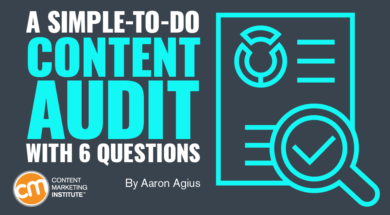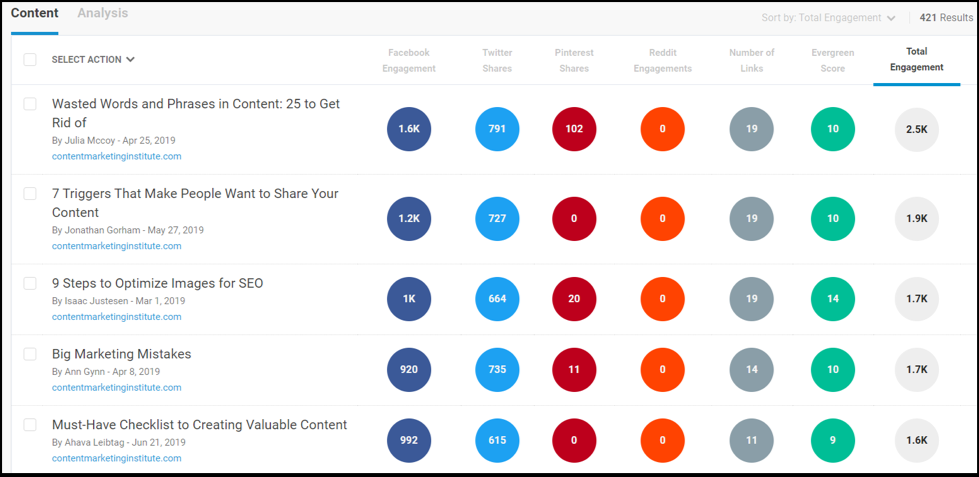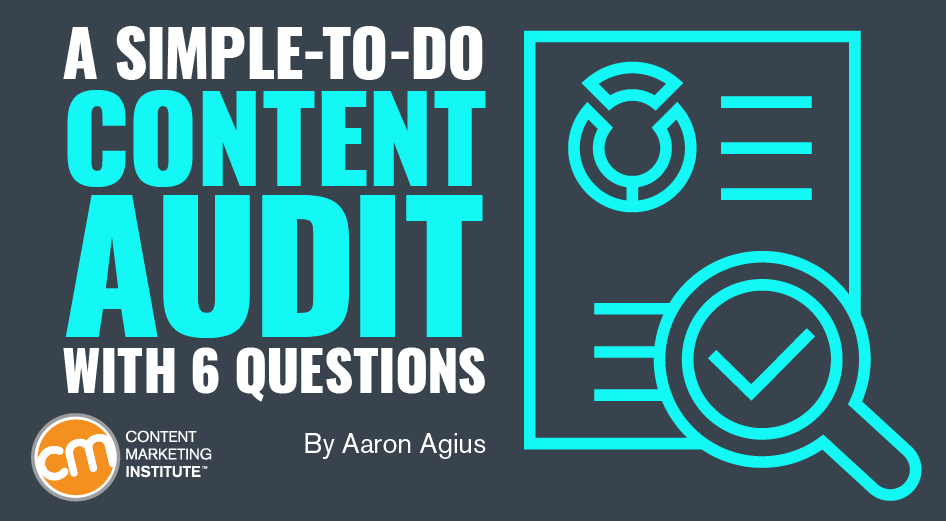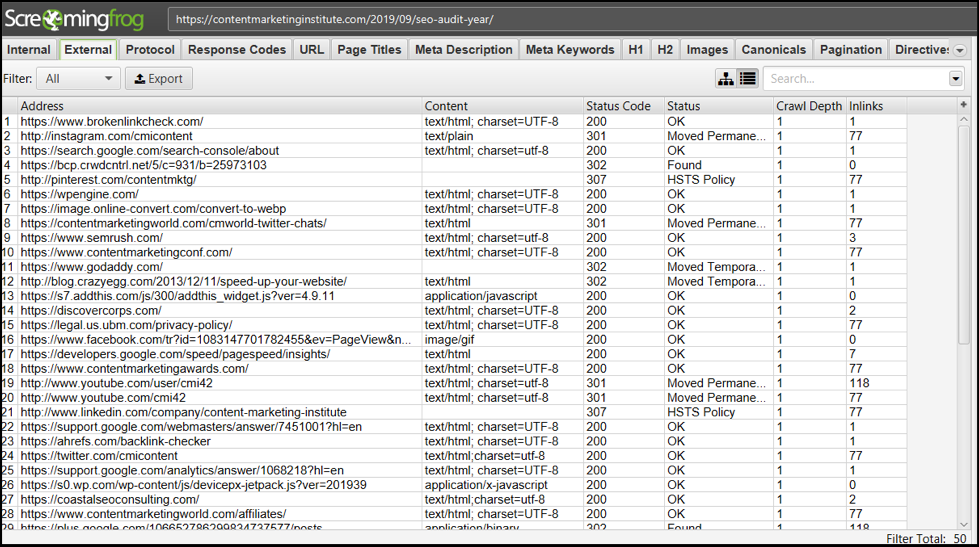
Planning your annual content audit is something most marketers are hard pushed to get excited about. Audits take time, they’re tedious and, frankly, they’re dull as ditchwater.
They’re also extremely important. Given how integral content is to the health of your brand, your visibility online. and your overall sales and marketing, you owe it to your business to keep your content in good working order.
You owe it to the business to keep your content in good working order, says @iamaaronagius via @CMIContent Click To Tweet
That said, there are no fixed rules on how to carry out your audit. Your content goals are specific to your business and audience, and you have your own interpretation of what’s working and what’s not. But to figure that out, every marketer can ask and answer the same six critical questions to inform whether you update, repurpose, or delete your articles.
Remind yourself of your audience and your goals
Before beginning the audit, go back to your audience. Revisit your reader profile(s), identifying who they are, what they want to be reading about, and what they want to achieve online.
Then go back to your overall content goals. What is your content designed to achieve? Conversions? Increased social media following? More subscribers?
Only when you’re clear on these two things can you ask relevant questions about your content.
Content audit questions
Before you start on these questions, set up a system for documenting your findings. Record existing blog content in an Excel or similar spreadsheet (use a website crawler like Screaming Frog SEO Spider to grab URLs from your website). Add columns – at least one for each question – so you can rate each content asset on a scale of 1 to 10. Some questions have multiple components. Create a column – and score – for each one. (Each scale’s meaning will depend on the question and your goals.)
TIP: If the volume of all your blog content is too great to do the audit at one time, segment it by date and schedule audit dates for each segment on your calendar.
1. Is the content still relevant?
Blog content, especially when it includes data or topical references, can get tired quickly. Review these articles at least once a year depending on how fast-moving your industry is.
Highlight time-sensitive references and data points. Check the age of source links (anything older than two years is outdated). After pinpointing the outdated references, decide whether the content asset is still valuable and should be updated with newer ones.
Any source link in your content older than 2 years is outdated, says @iamaaronagius @CMIContent Click To TweetMore broadly, look at whether the article still speaks to your audience. Is your main point still helpful? Or is the piece redundant?
2. How many people visit the post?
One of the best ways to determine the health of a content piece is to look at visitor data.
Determine how many people are viewing the page and how long they’re staying on the page (i.e., engaging with the content).
Go to your site’s Google Analytics account and drill down on that data.
Average organic search traffic per month
Your organic search traffic shows how many visitors a post is getting from search inquiries.
- Go to <Behavior>.
- Go to <Site content – All pages> and choose the relevant post page.
- Add a secondary dimension <Source>.
- Pick a time frame (at least the last three months) and calculate the average.
- Note all the search traffic sources besides Google.
Average overall traffic per month
Your overall traffic shows all the visitors to the post – from organic search, referrals, or direct traffic.
- Go to <Behavior>.
- Go to <Site content – All pages> and choose the relevant post page.
- Pick a time frame (at least the last three months) and calculate the average.
Bounce rate
Your bounce rate shows the percentage of visitors who navigate away from your site after only viewing one page. In most cases, you want this number to be as low as possible.
- Go to <Behavior>.
- Go to <Site content – All pages> and choose the relevant post page.
- Pick a time frame (at least the last three months) and calculate the average.

Average time on page
Like a bounce rate, average time on page indicates your visitors’ level of engagement with the post. In most cases, you want the average time on page to be high because the longer visitors stay on the page, the more they are reading and engaging with the content.
- Go to <Behavior>.
- Go to <Site content – All pages> and choose the relevant post page.
- Add a secondary dimension <Source>.
- Look at the average time on page
- Pick a time frame (at least the last three months) and calculate the average.

Once you collect this data, interpret the numbers based on your audience and content goals. For example, 300 monthly visits to a post could be a great success for one business and a failure for another.
As you collect data on more blog post pages, you’ll be better able to judge what success looks like.
3. What engagement is the post receiving?
Your social media accounts can help you determine how helpful your content is. Metrics such as “likes,” shares, and comments on social media demonstrate how visitors are engaging with the content.
Use a social analytics tool such as Sprout Social, BuzzSumo, or platform analytics (Facebook Audience Insights, Twitter Analytics, and Instagram Insights).

Note each of your post’s shares, “likes,” favorites, etc.
4. How strong are the SEO indicators?
The health of your article’s SEO score can indicate whether the post is worth keeping or updating. That said, endless elements can determine the relative SEO pulling power of each post. The trick is to choose the most relevant ones.
The health of an article’s SEO can indicate whether it’s worth keeping.@iamaaronagius @CMIContent Click To TweetNumber and quality of backlinks
A well-optimized blog post includes a handful of links from external authoritative sources and internal links across your site.
First, check each link to see if it still works and if the site is still authoritative.
Next, look at the number of linking root domains – the number of sites linking to this article. (Some crawling tools provide this information.) You also can determine if the numbers have been artificially inflated – thousands of links from a single domain should be suspect.
Metadata quality
A well-optimized meta description and page title are good for SEO – and logically, for drawing visitors to the page.
Look at how your blog post appears on the search engine results page (SERP):
- Do the page title and meta description fit in the available space?
- Are the relevant keywords clearly visible?
- Do they tell visitors enough about the post to encourage a click?
Keyword density
If you don’t have a list of keywords for your blog, then now’s the time to start.
Otherwise, compare your keyword list to each article. Identify the number and relevance of the keywords within your post, including the body content, headings (H1) and subheadings (H2). Each of these elements bears some significance to its performance in SERPs.
TIP: Don’t stuff your keywords into the content. That outdated practice will hurt your search results. Use only the most relevant in a natural way.
5. Is the post converting?
If the content’s goal is to drive conversions – blog subscriptions, purchases, event sign-ups, etc. – it’s easy to see if it’s achieving that if you set it up in Google Analytics.
In your Google Analytics:
- Go to <Conversions – Goals – Goals URL>.
- Choose the page to analyze.
- Look at the number of goal completions and goal value (if you’ve set this up) against the page.

6. What content is missing?
Once you’ve audited your blog posts, you can carry out a gap analysis. You can easily do this by evaluating your now-completed spreadsheet. Match your list of keywords to the existing blog content. What keywords have no or only a few articles attached? Those topics can be tackled in future content.
Update, repurpose, delete
By scoring each overall question and its sub-questions, you can assess what’s next for each blog post:
- Update posts with healthy scores (say, lots of 8 to 10)
- Repurpose posts with middling scores that can be improved with a little work (lots of 4 to 7)
- Delete posts with low scores (lots of 1-3)
Ready to audit
In practice, the reality of content auditing isn’t glamorous. But it’s a job that should be integral to the overall health of your marketing.
By answering pertinent questions for each blog post using a data-backed approach, you have a relatively objective analysis. This way, you can rest assured that the decision to update, repurpose, or delete the content is backed by good reason. You then can know that the content your brand is circulating remains high quality, is helpful for your audience, and contributes to your business’s marketing goals.
Please note: All tools included in our blog posts are suggested by authors, not the CMI editorial team. No one post can provide all relevant tools in the space. Feel free to include additional tools (from your company or ones you have used) in the comments.
Do you want to learn more about the tech side of content marketing? Gain knowledge and improve your content marketing results. Join us at ContentTECH Summit in August. Check out the agenda today.
Cover image by Joseph Kalinowski/Content Marketing Institute


